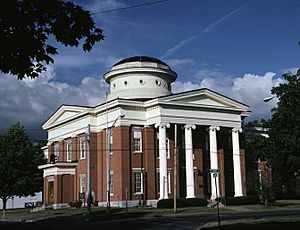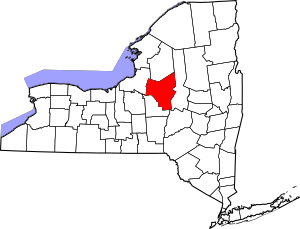Oneida County, New York facts for kids
Quick facts for kids
Oneida County
|
|||
|---|---|---|---|

Oneida County Courthouse
|
|||
|
|||

Location within the U.S. state of New York
|
|||
 New York's location within the U.S. |
|||
| Country | |||
| State | |||
| Founded | 1798 | ||
| Named for | Oneida people | ||
| Seat | Utica | ||
| Largest city | Utica | ||
| Area | |||
| • Total | 1,258 sq mi (3,260 km2) | ||
| • Land | 1,212 sq mi (3,140 km2) | ||
| • Water | 45 sq mi (120 km2) 3.6% | ||
| Population
(2020)
|
|||
| • Total | 226,654 | ||
| • Density | 191.5/sq mi (73.9/km2) | ||
| Time zone | UTC−5 (Eastern) | ||
| • Summer (DST) | UTC−4 (EDT) | ||
| Congressional district | 22nd | ||
Oneida County (/oʊˈnaɪdə/ oh-NYE-də) is a county in the state of New York, United States. As of February 26, 2024, the population was 226,654. The county seat is Utica. The name is in honor of the Oneida, one of the Five Nations of the Iroquois League or Haudenosaunee, which had long occupied this territory at the time of European encounter and colonization. The federally recognized Oneida Indian Nation has had a reservation in the region since the late 18th century, after the American Revolutionary War. The county is part of the Mohawk Valley region of the state.
Oneida County is part of the Utica–Rome, NY Metropolitan Statistical Area.
Contents
History
When England established colonial counties in the Province of New York in 1683, the territory of present Oneida County was included in a very large, mostly undeveloped Albany County. This county included the northern part of present-day New York State as well as all of the present state of Vermont and, in theory, extended westward to the Pacific Ocean. This county was reduced in size on July 3, 1766, to create Cumberland County, and further on March 16, 1770, by the creation of Gloucester County, both containing territory now in Vermont.
On March 12, 1772, what was left of Albany County was split into three parts, one remaining under the name Albany County. Tryon County contained the western portion (and thus, since no western boundary was specified, theoretically still extended west to the Pacific). The eastern boundary of Tryon County was approximately five miles west of the present city of Schenectady in the Mohawk River Valley, and the county included the western part of the Adirondack Mountains and the area west of the West Branch of the Delaware River. Tryon County was later divided to organize 37 distinct counties of New York State. The county was named for William Tryon, colonial governor of New York.
During and after the Revolution, most of the Loyalists in Tryon County fled to Canada. In 1784, following the peace treaty that ended the American Revolutionary War, Americans changed the name of Tryon County to Montgomery County to honor the general, Richard Montgomery, who had captured several places in Canada and died attempting to capture the city of Quebec. They replaced the name of the British governor.
In 1789, Montgomery County was reduced by the splitting off of Ontario County from Montgomery. The area taken from Montgomery County contained all of present-day Allegany, Cattaraugus, Chautauqua, Erie, Genesee, Livingston, Monroe, Niagara, Orleans, Steuben, Wyoming, Yates, and part of Schuyler and Wayne counties, as well as Ontario County.
After continued new settlement, in 1791 Herkimer County was one of three counties taken from Montgomery (the other two being Otsego, and Tioga County). It was much larger than the present Herkimer County, however, and was reduced by a number of subsequent splits.
In 1794, Herkimer County was reduced in size by the creation of Onondaga County. This county was larger than the current Onondaga County, including the present Cayuga, Cortland, and part of Oswego counties.
In 1798, Oneida County was created from another part of Herkimer County. This county was larger than the current Oneida County, as it included the present-day Jefferson (which extends along Lake Ontario), Lewis, and part of Oswego counties.
In 1805, Jefferson and Lewis counties were split off from Oneida. In 1816, parts of Oneida and Onondaga counties were taken to form the new Oswego County.
Together with Utica, Oneida county was the cultural centre of Welsh settlement in New York state. By the mid-nineteenth century, the lexicorapher John Russell Bartlett noted that the area had a number of Welsh language newspapers and magazines, as well as Welsh churches. Indeed Bartlett noted in his Dictionary of Americanisms that "one may travel for miles and hear nothing but the Welsh language". By 1855, there were four thousand Welshmen in Oneida.
In 1848, John Humphrey Noyes founded a religious and Utopian community, the Oneida Community, near Oneida. Its unconventional views on religion and relations between the sexes generated much controversy. The community lasted until 1881. The Oneida Silver Company was founded here to manufacture sterling silver, silverplate holloware and, later, stainless steel flatware.
Geography
According to the U.S. Census Bureau, the county has a total area of 1,258 square miles (3,260 km2), of which 1,212 square miles (3,140 km2) is land and 45 square miles (120 km2) (3.6%) is water.
Oneida County is in the central portion of New York State, east of Syracuse, and west of Albany. Oneida Lake is on the northwestern corner of the county, and the Adirondack Park is on the northeast. Part of the Tug Hill Plateau is in the northern part of the county. Oneida County's highest point lies neither on the plateau nor in the Adirondack Park, but in the county's southern extremity. The peak's name is Tassel Hill. It is located slightly southeast of Hardscrabble Road (Tassel Hill Road), between the villages of Waterville and Cassville.
The Erie Canal, completed in 1825, runs east–west along the Mohawk River through the county. It stimulated considerable trade and settlement. Oneida Lake and Oneida Creek form part of the western boundary.
In the early 21st century, Oneida is the only county in New York state documented as having Chronic wasting disease among its wild White-tailed deer.
Adjacent counties
- Lewis County – north
- Herkimer County – east
- Otsego County – southeast
- Madison County – southwest
- Oswego County – west
National protected area
Demographics
| Historical population | |||
|---|---|---|---|
| Census | Pop. | %± | |
| 1800 | 22,047 | — | |
| 1810 | 33,792 | 53.3% | |
| 1820 | 50,997 | 50.9% | |
| 1830 | 71,326 | 39.9% | |
| 1840 | 85,310 | 19.6% | |
| 1850 | 99,566 | 16.7% | |
| 1860 | 105,202 | 5.7% | |
| 1870 | 110,008 | 4.6% | |
| 1880 | 115,475 | 5.0% | |
| 1890 | 122,922 | 6.4% | |
| 1900 | 132,800 | 8.0% | |
| 1910 | 154,157 | 16.1% | |
| 1920 | 182,833 | 18.6% | |
| 1930 | 198,763 | 8.7% | |
| 1940 | 203,636 | 2.5% | |
| 1950 | 222,855 | 9.4% | |
| 1960 | 264,401 | 18.6% | |
| 1970 | 273,037 | 3.3% | |
| 1980 | 253,466 | −7.2% | |
| 1990 | 250,836 | −1.0% | |
| 2000 | 235,469 | −6.1% | |
| 2010 | 234,878 | −0.3% | |
| 2020 | 232,125 | −1.2% | |
| U.S. Decennial Census 1790-1960 1900-1990 1990-2000 2010-2020 |
|||
As of the census of 2000, there were 235,469 people, 90,496 households, and 59,184 families residing in the county. The population density was 194 inhabitants per square mile (75/km2). There were 102,803 housing units at an average density of 85 units per square mile (33/km2). The racial makeup of the county was 90.21% White, 5.74% African American, 0.23% Native American, 1.16% Asian, 0.02% Pacific Islander, 1.11% from other races, and 1.52% from two or more races. Hispanic or Latino of any race were 3.20% of the population.
21.7% were of Italian, 13.1% Irish, 12.1% German, 9.9% Polish, 8.5% English and 5.6% American ancestry according to self-identification of ethnic background in Census 2000. 90.6% spoke English, 2.7% Spanish, 1.3% Italian, 1.2% Serbo-Croatian and 1.1% Polish as their first language.
There were 90,496 households, out of which 30.40% had children under the age of 18 living with them, 49.10% were married couples living together, 12.00% had a female householder with no husband present, and 34.60% were non-families. 29.50% of all households were made up of individuals, and 13.10% had someone living alone who was 65 years of age or older. The average household size was 2.43 and the average family size was 3.02.
In the county, the population was spread out, with 23.90% under the age of 18, 8.60% from 18 to 24, 28.20% from 25 to 44, 22.90% from 45 to 64, and 16.50% who were 65 years of age or older. The median age was 38 years. For every 100 females there were 98.60 males. For every 100 females age 18 and over, there were 96.30 males.
The median income for a household in the county was $35,909, and the median income for a family was $45,341. Males had a median income of $32,194 versus $24,295 for females. The per capita income for the county was $18,516. About 9.80% of families and 13.00% of the population were below the poverty line, including 18.90% of those under age 18 and 8.50% of those age 65 or over.
2020 census
| Race | Num. | Perc. |
|---|---|---|
| White (NH) | 180,984 | 78.0% |
| Black or African American (NH) | 14,989 | 7.0% |
| Native American (NH) | 508 | 0.22% |
| Asian (NH) | 10,522 | 4.53% |
| Pacific Islander (NH) | 72 | 0.03% |
| other/mixed (NH) | 9,859 | 4.3% |
| Hispanic or Latino | 15,191 | 6.54% |
Economy
The main product of Oneida County was once silverware, chiefly manufactured at Oneida Ltd.'s headquarters in Sherrill. In January 2005, the company ceased manufacturing their product, closing its main plant and selling its assets. The factory, under new ownership, continues to produce American-made silverware under the Liberty Tabletop brand.
Currently the largest non-governmental, non-healthcare product of Oneida County is gambling. Turning Stone Casino Resort is an enterprise of the Oneida Indian Nation of New York, and the largest private employer in Oneida County.
Education
- Tertiary
- Hamilton College
- Mohawk Valley Community College
- Oneida Institute (defunct)
- State University of New York Polytechnic Institute
- Utica University
- Public school districts
- Adirondack Central School District
- Brookfield Central School District
- Camden Central School District
- Central Square Central School District
- Clinton Central School District
- Holland Patent Central School District
- Madison Central School District
- Mount Markham Central School District
- New Hartford Central School District
- New York Mills Union Free School District
- Oneida City School District
- Oriskany Central School District
- Poland Central School District
- Remsen Central School District
- Rome City School District
- Sauquoit Valley Central School District
- Sherrill City School District
- Stockbridge Valley Central School District
- Utica City School District
- Waterville Central School District
- Town of Webb Union Free School District
- West Canada Valley Central School District
- Westmoreland Central School District
- Whitesboro Central School District
- State-operated schools
- New York State School for the Deaf
Communities
Cities
Towns
Villages
Census-designated places
- Barneveld
- Bridgewater
- Chadwicks
- Clark Mills
- Durhamville
- Hamilton College
- Lake Delta
- Marcy
- North Bay
- Otter Lake
- Prospect
- Stittville
- Verona
- Washington Mills
- Westernville
- Westmoreland
- White Lake
Hamlets
- Blossvale
- Cassville
- Deansboro
- Jewell
- Lee Center
- Lower South Bay
- McConnellsville
- Point Rock
- Sauquoit
- Taberg
- Vernon Center
- Verona Mills
Notable locations
- Fort Stanwix
- Oriskany Battlefield State Historic Site
- Steuben Memorial State Historic Site
See also
 In Spanish: Condado de Oneida (Nueva York) para niños
In Spanish: Condado de Oneida (Nueva York) para niños



